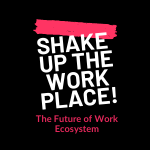
Hybrid meetings are not going to be any type of “new normal”. Hybrid meetings present a whole new set of challenges with some of the team in the room (IRL or In Real Life) and some by video. The challenge is making sure the remote participants are not overlooked, unengaged and uninspired. It needs new routines, rules, and rituals to make meetings inclusive, engaging, and productive.
Proximity Bias – Slow Down Decisions
Bias is everywhere in organizations, consciously and unconsciously, but remote meetings could exacerbate the issue with proximity bias. Proximity bias is that we remember the people that we see more often or have seen more recently. So the more visible team members, the ones who come to the office more often, will come to your mind. Then when you are choosing people for the next project or promotion, they are top of your list.
The people who are more likely to work remotely are those with caring responsibilities. Often in traditional families, this falls to women. Older people are more likely to have the space to work effectively from home. Therefore, they may choose to work remotely. So hybrid proximity bias could intensify already existing age and gender bias.
Interrupting this bias means slowing down decisions. For example, run through a mental list of all the potential people available for a project, don’t just jump into the first name that comes to mind. Or discuss with a colleague or do a competency-based review for promotions.
Participation – Build in a Routine
Proximity bias also impacts who is seen and heard during a meeting. Even when everyone is in the same room, it can be difficult for quieter people to be heard. A few loud voices can drown out everyone else. In hybrid meetings, this is even more challenging for remote participants to get a word in, not just the quieter team members.
It needs to become routine to ensure that everyone has had a chance to speak. It could be quite straightforward, such as asking everyone individually by name if they have something to contribute. That is more likely to get a response than just asking, “does anyone else have something to say?”. Alternatively, you could appoint a person in the room to watch the remote team members’ screen gallery and interjecting so they can speak. Breakout groups also help as it is easier to speak up in a smaller group. For larger meetings, whiteboards or polls allow people to express an opinion or engage with the content.
People – Space for Social
Remote work showed us that there is more to work than just the work. Work is vital to our social wellbeing. The space between meetings was where people socialized and teams bonded. When this was lost in the remote world, teams came up with ways to keep up social connections such as virtual coffees or cooking classes. But what happens now?
Make space in the schedule for the team to build social relationships, especially for new teams. If possible, organize that team members can get to know each other during a face-to-face kick-off session. If it’s a regular meeting, then take a few minutes to socialize. Give space and a topic where people can share where they are at, what’s happening outside of work. The important part is to ensure everyone is involved, not just the people in the meeting room.
I’m sure you’ve often thought “useless meeting but useful coffee break” when you had a chance to speak to a colleague or meet someone from outside of your core team. These social interactions help us to get work done. This is another time where IRL could have an advantage over their remote colleagues. I see some companies using software to set up virtual lunches and coffee breaks to develop social connections and break down silos.
Without the input and engagement of all your team members, your team won’t perform at its best. Diversity brings new perspectives creating innovation and improvement. To make sure your hybrid meetings don’t favor the IRL participants and perpetuate bias further, then check you’ve looked at the 3 P’s; interrupting proximity bias, building a routine for all members to participate, and creating time and space for people to socialize.

About the author: Jane Piper is an Organisational Psychologist and bestselling author of Focus in the Age of Distraction – a book looking at the impact of digital technology on our wellbeing and ways of working. She is interested in the intersection of humans and technology. She is a WeWent facilitator offering interactive training programs that help teams to focus their collective brainpower on solving the important challenges in the world today.










